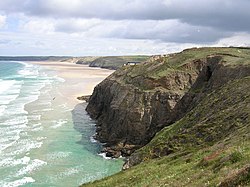Perranporth
| Perranporth Cornish: Porthperan | |
| Cornwall | |
|---|---|
 Perran Beach from Droskyn Point | |
| Location | |
| Grid reference: | SW756540 |
| Location: | 50°20’37"N, 5°9’17"W |
| Data | |
| Population: | 3,066 |
| Post town: | Perranporth |
| Postcode: | TR6 |
| Dialling code: | 01872 |
| Local Government | |
| Council: | Cornwall |
| Parliamentary constituency: |
Truro & Falmouth |


Perranporth is a small seaside resort town on the north coast of Cornwall. It is popular with surfers and tourists because of its spectacular beach, and Atlantic swell. It is six mles southwest of Newquay and seven miles northwest of Truro.
Perranporth and its 3-mile long beach face the Atlantic Ocean.
The village has a population of 3,066 and is the largest settlement in the parish of Perranzabuloe.
The village's modern name comes from Porth Peran, the Cornish for the “Cove of Saint Piran”, the patron saint of Cornwall. He founded St Piran's Oratory on Penhale Sands near Perranporth in the 7th century. Buried under sand for many centuries, it was unearthed in the 19th century.
Geography
Perranporth is centred on a main street, St Piran's Road, part of the B3285 Newquay to St Agnes road. The village centre has various shops and cafés including a Co-operative store, Premier convenience store, the Camelot restaurant and seven pubs. The long-distance South West Coast Path runs past the village.
Perranporth is a popular family holiday destination. A wide sandy beach, Perran Beach, extends northeast of the town for nearly 2 miles to Ligger Point. The beach faces west onto Perran Bay and the Atlantic Ocean and is a popular surfing location. There are lifeguard beach patrols from May to September and the beach is generally safe for bathing, although there are dangerous rip currents around Chapel Rock at ebb tides.
At the south end of the beach are cliffs with natural arches, natural stacks and tin-mining adits. There is a youth hostel above the cliffs at Droskyn Point. Nearby is the 19th century Droskyn Castle, formerly a hotel and now divided into apartments.
Protected areas
Perran Beach is backed by extensive sand dunes which extend nearly a mile inland. Known as Penhale Sands, the dunes are used for orienteering competitions and there is an army training camp which includes a live firing range, over which Ministry of Defence byelaws apply.[1]
There is also a golf course on the dunes. The dunes are not to be used by naturists, although the far north end of the beach is still a fairly accepted place for nudists. The dunes are also a valuable resource for wildlife with many rare plants and insects including Cornwall's largest colony of the Silver-studded blue butterflies.[2]
Southwest of Perranporth, the coast becomes more rocky, with cliffs rising to about 300 feet at Cligga Head. These cliffs form the Cligga Head Site of Special Scientific Interest, noted for its geological and biological characteristics.[3]
History
The Voorspoed ran ashore in a northerly gale in Perran Bay on 7 March 1901, while sailing from Cardiff to Bahia. The wreck was one of the last to be looted on these sands.[4]
Perranporth Airfield, built during Second World War as an RAF fighter station, is now a civil airfield. It is located at Cligga Head, on the plateau above the cliffs.
Until the 1960s, Perranporth was served by a railway line. Built as the Truro and Newquay Railway, the line ran from Chacewater to Newquay and the principal intermediate stop was Perranporth station.[5] Perranporth also had a second station, known as Perranporth Beach Halt.
Annual events
- The "Perranporth Shout", a sea-song and shanty festival is held over the third weekend in April, with performers from as far away as Norway.
- Inter-Celtic festival each October, Lowender Peran, drawing people in from Cornwall, Brittany, Wales, Scotland and Ireland.
Places of worship, associations and clubs
The parish church is in Perranzabuloe village, but there is an Anglican chapel of ease in Perranporth dedicated to St Michael, which opened in 1872.[6]
Masonic and fraternal associations
The town's Freemasonry|Masonic centre in Liskey Hill is home to 16 Masonic bodies, which makes it one of the foremost centres of Masonic activity in Cornwall.[7]
There used to be a Lodge of the Independent Order of Odd Fellows (Manchester Unity), who owned the Odd Fellows Hall, near the Ponsmere Hotel, but due to declining numbers this Lodge closed and the building is now rented by Cornwall Council as the town's library. The Oddfellows building is owned by Perranzabuloe Museum, which has a display gallery and research area above the library.
Sport
Surfing is very popular in Perranporth with its long sands and beach break. The Perranporth Surf Life Saving Club is one of the oldest in the country and hosts an extreme triathlon event every autumn. The beach is also a popular destination for Kite Surfing enthusiasts. There is a golf club, Perranporth Golf Club, just north of the village, while the football team Perranporth A.F.C. play in Division One West of the South West Peninsula League.
Outside links
| ("Wikimedia Commons" has material about Perranporth) |
References
- ↑ http://www.scribd.com/doc/97852050/Penhale-Light-Anti-Aircraft-Artillery-Range-Byelaws
- ↑ Wacher, John; John Worth and Adrian Spalding (2003). A Cornwall Butterfly Atlas. Newbury: Pisces Publications. ISBN 1-874357-23-4.
- ↑ "Cligga Head". Natural England. 1986. http://www.sssi.naturalengland.org.uk/citation/citation_photo/1002991.pdf. Retrieved 26 October 2011.
- ↑ http://www.telegraph.co.uk/culture/culturepicturegalleries/10397734/Shipwreck-photograph-collection-for-sale.html?frame=2711289
- ↑ Reade, Lewis (1983) Branch Line Memories; Vol. 1. Redruth: Atlantic Publishers ISBN 0-906899-06-0
- ↑ Information on Perranporth from GENUKI
- ↑ Province of Cornwall (2011)Cornwall Masonic Yearbook 2011/12 Truro:
